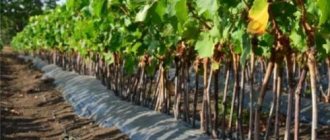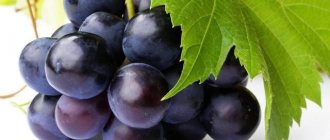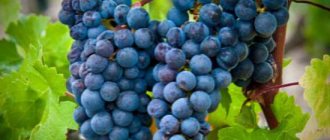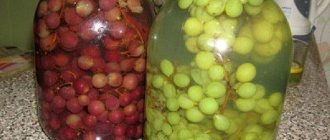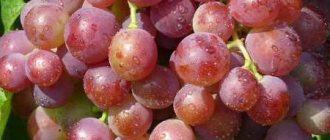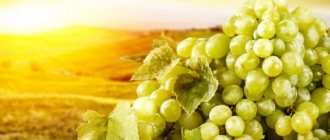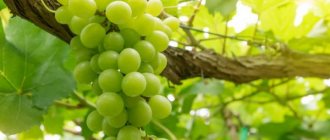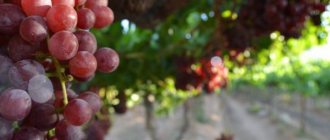Loading…
Loading…
Thanks to the emergence of new grape varieties and the constant improvement of the qualities of old ones, the geography of plantings of this crop in the country is expanding every year. Today, winegrowers can choose from hundreds of varieties for technical and table purposes, which, even in the difficult conditions of Russia, produce decent yields of sweet large berries that can withstand severe frosts and other vicissitudes of the climate.
Grapes Victoria
A hybrid of European and Amur grapes, the table variety Victoria received from its ancestors high winter hardiness and productivity, unpretentiousness and resistance to cultural diseases.
The vine overwinters well at temperatures down to –27 °C. For the growing season and ripening of berries, rather low-growing plants require from 115 to 120 days. Victoria grapes are characterized by abundant ovary formation, so sometimes rationing of the clusters is required. On adult bushes it is recommended to leave from 25 to 30 buds, but shoots can be trimmed either by 5–8 buds or much shorter – by 2–4 buds.
In some years, peas are observed. For a more friendly formation of clusters, it is desirable to have pollinating grapes on the site that bloom at the same time as Victoria.
Conical, moderately dense clusters consist of large berries weighing up to 7.5 grams, and have an average weight of 500–700 grams. The shape of the beautiful pink-red berries is oval or ovoid. When fully ripe, the sweet, slightly acidic fruits of Victoria grapes acquire additional muscat notes.
Grapes Lydia
One of the old grape varieties received a new life from Russian amateur winegrowers in the middle zone, where it established itself as a reliable supplier of aromatic sweet berries. The history of the variety began in the 60s of the last century. At this time, Lydia became widely known in traditional viticulture areas, and now a high-yielding vine, producing up to 40 kg of berries per bush, can be seen in the Central Black Earth Region and the Moscow region.
Lydia grapes, which have medium ripening periods and high winter hardiness, belong to both table and technical varieties. The direct ancestors of the grape variety contain the American species labrusca, which explains the specific bright aroma of Lydia, the increased mucilage of the berries and their “foxy taste”.
On tall bushes medium-sized cylindrical-conical brushes are formed. The berries are round and have a dense skin, pink-violet or dark red color and a pronounced bluish waxy coating. The taste is harmonious. In favorable years, Lydia grapes accumulate sugar well.
Due to its unpretentiousness, if climatic conditions allow, the variety can be grown without shelter and used for landscaping a personal plot, arches and gazebos. As a technical variety, Lydia grapes are good for making juice, as well as aromatic dessert and fortified wines.
Rostov region
The climate of the Rostov region is also suitable for growing the best grape varieties. There is enough light, heat and moisture here. However, to select a type (covering and non-covering), you should visually divide the area into 2 parts, above Kamensk and below. Non-covering varieties are recommended for planting in the south.
Not everyone knows the fact that wines are produced in the region that represent real competition to French collection drinks. Among the popular varieties:
- Valentina;
- Autumn black;
- Mascot;
- Arcadia;
- Somerset Seedliss et al.
Every year, vineyard owners practice updating the range of varieties, using proven grape varieties and the latest developments. A new approach and the use of innovative technologies makes it possible to increase the profitability of agricultural enterprises, bringing their achievements to the world level.
The Krasnodar region is considered ideal in terms of climatic conditions for growing grapes. But even despite this, it is necessary to choose the right variety in order to achieve an excellent harvest.
Grapes Senator
The hybrid form obtained by E.G. Pavlovsky as a result of crossing chocolate grapes and Podarok Zaporozhye is distinguished by early ripening, high growth rate and resistance to known diseases and pests of grapes. The vine tolerates frosts down to –23 °C.
Already at the end of August or September, medium-dense large clusters, weighing on average 600–750 grams, ripen on the Senator grape bushes. The bunch consists of smooth, oval large berries, weighing more than 11 grams. The dark red color of the fruit is hidden under a bluish waxy coating. The pulp has a pleasant consistency, not runny, aromatic, with nutmeg notes in the taste. The bunches of this grape variety are well stored and can be transported without loss.
Grapes in Kuban: harvesting (video)
Autumn planting of seedlings must obey several rules:
- Preventing the root system from drying out. The seedlings are soaked in water for a day, after which the roots are shortened by a quarter of their length. The shoots should also be shortened, leaving 3 or 4 buds. Weak branches are removed.
- At any time of planting, planting holes are made with a length of at least 80 cm on each side, and the soil in them is fertilized with humus and a mixture of fertilizers. If the soil is clayey, add a little sand to it; if, on the contrary, it is compacted by adding loam.
- When planting in autumn, the timing should be calculated based on when the roots can take root, and after that persistent frosts will occur. The seedlings are covered with a plastic bottle with ventilation holes, and after the onset of frost, the seedling along with the bottle is completely covered with soil or peat, creating a mound 30-40 cm high.
- When planting in spring, around mid-April, when the soil thaws and warms up, the seedlings need to be shaded from the sun so that they do not die due to drying out or burns.
Both in spring and autumn, grapes require abundant watering. Late and early varieties need moisture equally, so 2-3 buckets of water are poured under each bush at intervals of two weeks.
Grapes Cardinal
One of the most famous grape varieties of American selection, which appeared thanks to the “parental couple” Alphonse Lavallee and the Queen of the Vineyards Cardinal, became widespread in France, the Balkans, Italy and other traditionally viticultural southern regions.
On the one hand, the Cardinal grape attracts with its very large, round berries with characteristic grooves and clusters up to 30 cm long, which ripen by mid-August. The bunches are easily stored for up to three months and transported. The berries accumulate a lot of sugar and traditionally deserve high marks from experts. This variety is excellent for growing in a summer cottage.
On the other hand, the magnificent table grape variety, which delights with the fleshy pulp of purple aromatic berries, is extremely demanding and produces stable yields only on fertile soils and plenty of heat. Under unfavorable conditions, the ovary or flowers fall off, the berries do not develop properly and ripen in the “pea” stage.
At the same time, Cardinal grapes are often affected by harmful fungi and gray rot; medium-sized bushes and numerous pests are not spared.
Thanks to the work of Russian and Ukrainian breeders who did not want to put up with the shortcomings of an excellent grape variety, Cardinal varieties appeared that retained the taste qualities of their predecessor and were easily distinguishable by the shape of the berries, but were more winter-hardy and resistant to disease.
Grapes Cardinal resistant
The resistant Cardinal grape was obtained by crossing the Moldovan Criuleni grape and the famous American Cardinal. As a result, the variety received early ripening periods, from 115 to 120 days, retained the large size of the brushes characteristic of Cardinal, and the size of dark pink or purple berries.
At the same time, the shoots survive frosts down to –22 °C well, but in harsh continental winters they require shelter. The shoots of this variety of Cardinal grapes ripen well, and the risk of flowers shedding and peas is significantly reduced. The vine is more resistant to rot and mildew.
In the conditions of the Crimea, Kuban and Krasnodar Territory, plants of this grape variety produce clusters weighing from 500 to 900 grams. The berries reach a weight of up to 9 grams, have a dense, fleshy texture and a decent nutmeg taste.
Features of care
The early ripening hybrid Kuban will regularly bear fruit on any land if it is provided with proper care. It includes: watering, fertilizing, pruning the bush and preventive treatments for diseases.
In the spring, weak shoots and dry branches of grapes are cut off and excess buds are removed. After pruning, there should be 35-40 eyes and 30-35 green shoots left on the bush. In the summer, unfruitful stepsons that form in the axils of the leaves are picked off. In the fall, after the leaves have fallen, the main part of the branches is pruned and the bush is covered for the winter.
To increase productivity, Kuban grapes are fed with organic and mineral fertilizers. The procedure is carried out three times a year:
- in early spring, before the buds open, apply complex fertilizer;
- before ripening - superphosphate and potassium supplements;
- after flowering - potassium fertilizers.
In autumn, once every three years, slurry is used at the rate of 1 kg/1m2.
Kuban grapes need to be watered rarely, but abundantly. Depending on the soil composition and weather, it is advisable to irrigate once every 25-30 days. In summer, watering is carried out more often, once every 7-14 days, in the evening or morning. In August, when the berries are ripening, the watering is removed. And in the fall, moisture-recharging moistening is carried out.
One bush consumes 5-20 liters of water. It should be warm and settled.
Disease Prevention
The Kuban grape variety is resistant to gray rot and mildew, but can be affected by other common diseases. Therefore, carefully care for the berry bush: remove weeds and prune.
They also carry out preventive spraying of grapes with special means:
- before flowering;
- after flowering;
- after harvest.
Bordeaux mixture, copper and iron sulfate are used for processing. The most effective against pests are Fitoferm, Fozalon, and Iskra.
Grapes Cardinal AZOS
In Anapa, Russian breeders obtained their own Cardinal, which requires 120–125 days to mature. Possessing increased winter hardiness and resistance to pest fungi, Cardinal AZOS grapes form vigorous bushes with shoots that ripen well by autumn.
Like the American grape variety, the Russian Cardinal has very large clusters that can weigh more than a kilogram, as well as crunchy, sweet reddish-blue berries, bastre, which accumulates sugar more effectively than its predecessor.
Rochefort grapes
The Cardinal grape gave rise to a whole family of interesting varieties and hybrids. The Rochefort grape appeared as a result of crossing E.G. Pavlovsky Cardinal seedlings with Talisman grapes.
The resulting grapes, whose berries require 105–110 days to ripen, are classified as super-early or early varieties. Rochefort grape bushes have high growth vigor and good ripening of annual shoots. From 4–6 meters of area, up to 24 shoots can be fed, and it is recommended to use pruning of 6–8 buds.
The vine tolerates frosts down to –23 °C, suffers little from wasp invasion, has average resistance to mildew, slightly less to powdery mildew, and in relation to phylloxera, the grape variety requires special serious protection.
Dark red or purple berries, picked sourly and weighing up to 900 grams, can become almost black in color and weigh up to 12 grams. The berries have fleshy pulp with an unobtrusive nutmeg flavor and are dense, but do not interfere with fresh consumption. Rochefort grapes are distinguished by the highest marketability and taste.
Consumer Reviews
The wines of the Krasnodar region have found their fans in their homeland. Many consumers leave positive reviews about the quality of the product. For example, dry wines received the following rating from buyers:
- the drink has a pleasant taste;
- despite the fact that the wine is dry, no acid is felt;
- no alcohol taste;
- the drink goes well with fruit and dark dark chocolate;
- reasonable cost of the product (about 270 rubles per 0.7 liter bottle).
The line of Krasnodar wines is very large, so every gourmet can choose a drink that suits his taste. In addition to red and white, dry, semi-sweet and dessert wines, there are delicious sparkling wines. Champagne is one of the most popular drinks for ladies, without which not a single romantic dinner, wedding or New Year is complete.
People who at least once in their lives have taken a tour of a winery, learned the secrets of production, attended a tasting, take with them indelible impressions of this amazing and picturesque region.
Tags: wine, grapes, Kuban, variety, good
About the author: admin4ik
« Previous entry
Grapes Ruslan
A productive hybrid form of table grapes selected by a famous enthusiast from Ukraine, V.V. Zagorulko, obtained as a result of crossing Kuban and Gift to Zaporozhye. The resulting Ruslan grapes have early ripening, winter hardiness within –24 °C and a high percentage of ripening of one-year-old shoots.
The vine of this grape variety grows quickly, has increased resistance to oidium and mildew, and already in mid-August produces medium-density, large clusters, weighing on average about 700 grams. The Ruslan grape has large, oval, dark-gray berries due to the waxy coating of the berries, weighing more than 12 grams. The consistency of the fruit is dense and sweet. The brushes are stored well, and the berries do not lose their juiciness or appearance.
Krasnodar region
The climatic conditions of the Krasnodar Territory are considered ideal for grapes, so the best varieties are grown in this area. The ratio of warm days a year, average precipitation and sunlight make a good foundation for stable fruiting of the vineyards.
The main grape production is concentrated in the Anapo-Taman zone. The harvested crop is distributed to other industries for processing and to markets for fresh consumption. Harvesting time begins in the third decade of July and lasts until mid-October.
It is impossible to list all the varieties grown in the Krasnodar Territory, since the vineyards are constantly replenished with new developments by breeders. The following varieties of culture are considered the most popular:
Madeleine Angevin
Vigorous plant of early ripening. The harvest begins in mid-August. Productivity depends on the quality of pollination; the best pollinator is Chasselas, so both crops are planted nearby. The average weight of a bunch reaches 180-200 g. The berries contain 15% sugar and 6.7% acid.
Pearl Saba
The berries ripen in late July - early August. The yield is high (over 8 kg per bush), the stepsons bear fruit abundantly. After planting the chibouks, the plant bears fruit for 2-3 years. The ratio of sugar content (16%) and acidity (7.3%) is close to ideal. It has strong immunity and resists fungal diseases. Due to the shortage of planting material, propagation by grafting is practiced.
Chasselas white
It is one of the main ones, which is grown massively in the Krasnodar region. The plant enters the fruiting phase early (already in the 2nd year), the bush is formed of medium size, the immunity is strong, which can be seen in resistance to fungal diseases. The berry has high taste (sugar 15%, acid 6.7%) and good transportability.
An early ripening variety, found throughout the region, but in small quantities. The harvest is ready for harvest in the third ten days of August. On tall bushes, large clusters are formed abundantly, the weight of which reaches 420-500 grams. Productivity depends on the quality of pollination; the best pollinator is Chasselas, so both crops are planted in close proximity. Sugar content – 14%, acidity – 6%.
Muscat Hungarian
The plant enters the fruiting phase in the 3rd year after planting the seedlings. Muscat bushes are medium-sized with actively developing vines. The honey taste of the berries indicates a high sugar content (more than 20%), with relatively low acidity (6.5%). A medium-sized bunch weighs up to 160-170 grams. Intended for fresh consumption of berries and for processing into juices.
The plant comes from France and is characterized by high productivity. More than 7 kg of berries are removed from the bush. The grapes reach ripeness by the second half of September. The berries are large in size, dark blue in color with a characteristic waxy coating. The taste harmoniously combines sugar content (18.3%) and acidity (7%). The weight of a medium-sized bunch is 232 grams.
An equally varied menu of grape varieties grown on the peninsula. The total number of varieties is close to a hundred. Favorable climatic conditions and soil fertility contribute to high yields. The lack of precipitation is compensated by equipping the vineyards with a drip irrigation system. When planting plants, the following scheme is used: 3x1.5 m. The largest plantations are located in the foothill zone (Bakhchisaray district), steppe zone (near Simferopol), as well as in the suburbs of Yalta, Alushta, Sudak.
Among the fruitful ones the following stand out:
The table variety comes from Dagestan and is distinguished by its late ripening period. Harvesting begins no earlier than the 20th of September. The plant develops normally in soils with a high salt content. In addition to fresh consumption, the crop is used for canning and making juices.
Albillo Crimean
A medium ripening plant native to Spain. Grown for winemaking. The yield is 7-9 kg per bush. The berry contains 14% sugar and 6.7% acid.
Large grapes collected in loose clusters, the average weight of which reaches 450 grams. Yellow-amber berries have a pleasant taste with a pronounced nutmeg note.
The berries ripen by the end of August. The bunch is formed loose with a large number of grapes, the average weight is 250-350 grams. The taste is not cloying, although it contains at least 16-17% sugar. It is resistant to fungal diseases and has good transportability.
Citron Magaracha
Wine variety with early ripening. The quality of taste and presentation makes the berry edible and fresh. The weight of a cylindrical brush reaches 400 g. Sugar content is high (23%) with acidity 5-7%.
The crop is grown for fresh consumption and for the production of wine material. White berries ripen in late September - early October. Large bunches weigh up to 280 g. Even after being stored in the refrigerator for 5 months, the grapes do not lose their taste and commercial qualities.
Grapes Original
An attractive table grape of Ukrainian selection was obtained by crossing the Datier de Saint-Vallee variety and the Damask rose. Original grapes require 135 to 145 days to ripen, and the plants form vigorous bushes that are resistant to phylloxera and diseases caused by fungi.
The vine can withstand a load of up to 60 buds, while the plant responds well to feeding and care, but is sensitive to negative weather conditions, which is reflected in peas and average yield. In some years, the shoots of the table grape variety do not ripen well enough, which can be prevented by normalizing the clusters and carrying out pinching.
Moderately dense or loose clusters of this variety weigh 400–600 grams. The very large berries have an attractive pink color and an elongated nipple-like shape with a characteristic pointed tip. Due to the insufficiently strong attachment of the berries to the stalks and juicy tender pulp, it is not recommended to store and transport Original grape clusters.
Growing grapes: Krasnodar region
Grapes in the Krasnodar region are grown on an industrial scale. In most cases, winegrowers build their “plantations” on sunny plains or slopes. If you give preference to shady places, you will be able to grow grapes, but you are unlikely to get a large harvest. But, despite industrial development, there are many home gardeners in Kuban.
Features of viticulture in Kuban
Caring for grapes in the spring in the Kuban and generally growing grapes in these surroundings has its own characteristics.
- The soil must be loosened to provide the root system with oxygen. Another equally important task of loosening is to facilitate the penetration of moisture into the soil.
- With the onset of spring, the crop must be fertilized with nitrogen-containing compounds; in the summer this can no longer be done.
- In spring, agronomists do not spare water on plants, since the amount of melt water in the region is at a low level.
Special attention should be paid to processing grapes in the spring in the Krasnodar Territory. Despite favorable growing conditions, there is also a high probability of crops being damaged by diseases or pests. The most dangerous are the grape cicada, leaf roller and grape mite.
When to spray grapes in Kuban? How to treat grapes before flowering in Kuban? If there is a high risk of mildew, gardeners should spray the bushes with a solution of copper sulfate (concentration of the active substance is 3%). Preventive spraying must be repeated in the fall.
Bordeaux mixture also shows good effectiveness. It is necessary to spray the bushes and soil around the vine before the plant begins to bloom. It is necessary to process grapes before watering. This preliminary care will protect the bushes from the appearance of aphids.
The ripening period of Kuban grapes primarily depends on the variety. However, under favorable weather conditions, local residents harvest the first harvest several weeks earlier than winegrowers from more northern regions.
Growing grapes
The Krasnodar region is famous for its fertile lands and favorable climate. Growing Kuban grapes is not difficult; wine (technical) and table varieties are available for cultivation.
Spring pruning of grapes in Kuban should be carried out shortly before flowering. It is necessary to prune broken, wounded, dry and non-fruiting shoots. For pruning, use only sharp and clean objects.
Important! During pruning, the vine must not be crushed. Not only the abundance of fruiting, but also the health of the crop will depend on a competent approach.
The main care for grapes in the summer in Kuban is timely tying of bunches, regular watering and careful inspection of shoots for the appearance of diseases.
Caring for grapes in spring in Kuban
The vines should be tied vertically or at a slight angle in the direction of growth. Fruitful vines are tied in such a way that several of them are not located close to each other.
In Kuban, special attention is paid to treating plants against various pests, because in a warm and humid climate they develop at an amazing speed. If left unchecked, pests can destroy large areas of vineyards.
Grapes Original New
The Original New or Zagrava grapes are a hybrid obtained by crossing the already known varieties Original and Kobzar, the berries of which take 135 to 145 days to ripen. Compared to its predecessor variety, Original New, it is distinguished by the absence of peas, brighter berries with dense pulp without excessive softness and thinner skin.
The grape variety produces extremely large clusters, weighing more than a kilogram, consisting of white-pink berries, clearly recognizable by their shape and color.
To obtain intensely colored berries, Zagrava recommends thinning the foliage near the clusters and not allowing the shoots to become too dense. In the Original New grape, the vines are not damaged at temperatures down to –22 ° C, and the hybrid is also characterized by increased resistance to common grape diseases. Wasps also do not cause serious damage to crops.
Valek grapes
From crossing Rizamat, variety Kesha 1 and grapes Zvezdny amateur breeder N.P. Vishnevetsky received the Valek grapes, which ripened in just 105 days. The plant in its own root culture is characterized by a high growth rate, excellent yield and ripening of annual growth. The vine tolerates winters with temperatures not lower than –24 °C without significant losses, and is rarely infected with pathogenic fungi and rot.
The grape variety is distinguished by the friendly formation of the ovary even in years with unfavorable weather conditions. At the same time, massive brushes are formed on the bushes, sometimes reaching a weight of up to 2.5 kg and having a very attractive appearance for the consumer.
The berries, weighing about 15 grams, have a fleshy texture, an attractive yellow color and an unusual pear flavor. Muscat tones are clearly visible in the sweet taste of Valek grapes. The bunches can be transported and stored without harm to the berries.
Long-awaited grapes
The Long-awaited grapes were received by V.N. Krainov from a couple of well-proven table varieties: Kishmish Radiant and Talisman. This hybrid form is characterized by early maturation. In the conditions of Kuban and Crimea, the first brushes can be removed in early August. At the same time, the bushes annually produce high, well-ripened growth and are resistant to common diseases and frosts down to –25 °C.
Consisting of elongated nipple-shaped berries of white or yellowish color, the berry clusters weigh 500–800 grams and have a beautiful conical shape. The average berry weight is 8–9 grams. The pulp of the Long-awaited grape fruit is fleshy and juicy with a harmonious taste, the perception of which is not hindered by the medium thickness of the skin.
Grapes Jupiter
Jupiter grapes were obtained by American breeders and classified as seedless grape varieties. Of the dark-colored varieties of this type existing on the market, Jupiter stands out for its high frost resistance, down to –27 °C, and good immunity to diseases caused by fungi and common pests. It is these qualities that have made the grape variety popular among Russian winegrowers.
Compared to the varieties described above, Jupiter produces small brushes, weighing up to 250 grams. Its berries also cannot be called record-breaking. Their weight varies from 4 to 6 grams, the fruits have a rich purple or blue color. The grape variety quickly accumulates sugar, the fruits do not crack, and small rudiments are only occasionally found in the juicy, fleshy pulp.
What are the differences between wine grape varieties?
Wine can be made from any grape if desired. However, it is the variety that determines the bouquet, color and taste of the drink. To obtain high-quality wines, technical grape varieties, or, as they are also called, wine grapes, are used. Compared to table grapes, they have smaller bunches. The berries are very juicy, but small or medium in size.
The juice content in them reaches 75-85% of the total mass. Depending on the ratio of sugars and acids in the pulp, different types of wines are obtained from them - dry, sparkling, dessert. In technical varieties, the sugar concentration reaches more than 18%, and there should also be a lot of coloring and extractive substances. They influence the richness of the wine and determine its aromatic bouquet and color.
Grapes Talisman
The white grape variety Talisman has a table purpose and is widely known for its good resistance to common crop diseases, frost resistance and large berries of good taste.
The ripening period for grapes obtained from crossing Delight and Frumoas Albe is 125–135 days. With high vine growth vigor, the shoots ripen well by autumn and provide a bountiful harvest the following year.
The clusters of Talisman grapes are not too dense, conical in shape, and can weigh more than 1200 grams. At the same time, the oval berries of this variety are also worthy of attention. They are very large, weighing from 12 to 16 grams and have a good consistency and pleasant taste, which after ripening appears a nutmeg shade.
Composition of white and red wines
French-Russian production, producing the best wines of the Krasnodar region, reviews of which can be found in the guest book, has numerous awards and diplomas, occupying a leading position in the European wine market.
The most popular are:
- "Lands of the South".
- "Royal Oak".
- "Selection Cabernet Saperavi".
- "Solo".
- "Cuvée Karsov".
Visiting guests who want to get acquainted with the art of winemaking and taste the wines of the Krasnodar region can comfortably stay in a hotel that is ready to receive visitors in any season. The influx of tourists occurs at the end of spring - beginning of autumn. There are a lot of people who want to learn the intricacies of winemaking.
Wine production in the Krasnodar region is developing in parallel with tourism. Visitors to Chateau le Grand Vostok, getting acquainted with the technology, will learn a lot of interesting things about the history of the drink.
The first plantings appeared in 2006-2007. The seedlings were brought from France. Today the farm grows both domestic and European grape varieties. The most popular are:
- Chardonnay.
- Sauvignon Blanc.
- Marsan.
- Rusan.
- Riesling.
- Cabernet Sauvignon.
- Cabernet Franc.
- Grenache.
- Malbec.
Wine has beneficial properties, and this is not surprising, since it contains various microelements. The drink has a small protein content (2 g), and during the period of clarification of the wine material, their amount decreases significantly.
Of the mineral salts, potassium occupies the largest share (from 700 to 1600 mg). There are approximately equal amounts of magnesium and calcium in wine, from 50 to 200 mg. The content of phosphorus salts is 100-200 mg, but the sodium in the drink is about 20-250 mg.
It is worth noting that wine is very rich in iron, so you can often hear that for anemia and low hemoglobin it is recommended to drink a small amount of red wine. This microelement is ionized, due to which absorption into the body’s cells occurs very quickly. The composition also contains useful substances such as zinc, copper and manganese.
The drink contains no vitamin C at all, but there are quite a lot of representatives of group B:
- riboflavin;
- pyridoxine;
- thiamine;
- niacin;
- pantothenic acid.
The south of Russia is rich in wine-making enterprises, whose drinks participate in various domestic and international exhibitions. September was marked by stunning success, as a tasting competition was recently held in Austria, in which a huge number of brands participated. The selection of the best samples was carried out blindly. Winemaking and Fanagoria received high awards: 3 gold and 8 silver.
This is a great achievement, especially considering that approximately 13,000 wines from more than 1,800 brands from 41 countries participated in the competition.
Wines received three gold medals:
- “Cabernet one hundred shades of red” (2013).
- “Saperavi one hundred shades of red” (2014).
- "Vintage Cahors" (2011).
The latest sample also made it into the top three best strong wines.
Many travelers and connoisseurs of a good glass of wine take with them not only a bottle of “Chateau”, “Lefkaria”, but also homemade wines of the Krasnodar region, prepared according to ancient recipes of local residents. Homemade wines surprise with their variety and combination of flavors.
How pleasant it is on a cold evening with your family to remember the sunny sky of Crimea, the endless vineyards stretching to the horizon, the aroma emanating from the vine, and drink a glass to those who prepare the drink that excites our hearts.
Crystal
Vineyards in Crimea occupy large areas. About 30 cultivars for technical purposes are grown on the peninsula. Most Popular:
- Gars Levelu and Furmint are Hungarian varieties used for the production of Tokaji dessert wines;
- Muscadelle - used to make white dessert wine;
- Pinot - the name of the variety is translated as “cone”, since its clusters have a cone-shaped shape; the berries are used to make vintage sweet dessert drinks;
- Albillo is a Crimean white grape that improves the taste of port wine;
- Cabernet Sauvignon;
- Riesling is a German variety with white berries, suitable for making light table wines. The best Rieslings in Crimea are grown at the Zolotaya Balka state farm.
In addition, wines in Crimea are made from dessert varieties (mostly from Muscat White). The best Muscat wine is produced from grapes grown in the Livadia, Massandra and Gurzuf microdistricts.
- Crystal;
- Isabella, which in Belarus is called “Brest Blue”;
- Platovsky;
- Citron Magaracha - bred in Crimea, sugar content 25-27%, the famous Muscatel White wine is made from this variety.
Unfortunately, despite the possibility of growing its own varieties, the Belarusian industry works mainly on imported Italian raw materials, since its own industrial viticulture is not developed in the republic.
Grapes Lowland
The author of this hybrid form of grapes is V.N. Krainov. Thanks to the crossing of the Tomaisky and Talisman varieties, Nizina grapes were obtained, which ripen in 125–130 days and are classified as medium-ripening varieties. The minimum temperature tolerated by shoots is –23 °C.
The cylindrical, not very dense bunches of Nizina grapes weigh 600–700 grams; in some cases, the clusters grow up to one and a half kilograms. Reddish-purple attractive oval-shaped berries have a harmonious taste, a fleshy consistency with sufficient juice content and a weight of up to 14 grams.
Grapes Crystal
The Hungarian selection of Crystal grapes was obtained from a complex crossing of Amur and local grape varieties with the well-known Villars Blanc grape. The berries of a productive variety that ripen in 110–120 days are an excellent raw material for the production of table wines and dry white sherry.
This grape variety has an average growth rate and excellent winter hardiness, allowing the vine to be cultivated in regions where frosts down to -29 °C are not uncommon in winter. The bushes are not damaged by rot, but their resistance to fungal infections is very average. When growing this variety, it is important to avoid excessive bush density, which leads to shedding of the ovary and a drop in yield. The sugar content and acidity of Crystal grapes are greatly influenced by weather conditions during ripening.
The variety is characterized by clusters weighing 170–200 grams, consisting of round or oval yellowish-green berries weighing up to 2.5 grams. The consistency of the fruit is juicy, the taste is harmonious, transmitted to drinks made from grapes.
Vineyards "Chateau"
Grapevine plantations in the Krasnodar lands occupy many kilometers of plantations.
Fruit-bearing bushes spread over 250 hectares, and young vines are gaining strength on 120 hectares. French winemakers, who know a lot about good wine, chose to plant vineyards on the lands of Krasnodar, having previously studied climatic and soil indicators. Under the sunny sky, grape plantations lie in tiers on hills and slopes 150-350 meters above sea level.
Initially, existing land was used to grow vines, which was about 500 hectares. But over time, a young vine was brought from France. The Mercier nursery provided the project with new grape seedlings of various varieties, which were planted for wine production.
Grapes Rusbol
Villars Blanc, paired with Super Early Seedless grapes, gave winegrowers another interesting grape variety. These are Rusbol grapes, which produce a harvest 115 - 125 days after the buds revive. The table variety begins to form inflorescences already 2–3 years after planting, and as the bushes mature, their growth vigor noticeably increases, and the growth steadily matures.
Rusbol grapes tolerate frosts of about –25 °C and are well resistant to attacks by pests and pathogens. A characteristic feature of Rusbol is the overload of filling brushes, so pinching and crop rationing are mandatory procedures for this grape variety.
This grape, classified as class VI of seedless grapes, is characterized by the formation of extremely large, highly branched clusters, weighing from 400 grams to 1.5 kg. The berries are oval, greenish-yellow, very sweet with soft rudiments of seeds in the juicy pulp.
The Rusbol grape has earned the attention of winegrowers and breeders, so several interesting varieties have been created on its basis today. An example of this is Rusbol improved and Rusbol nutmeg. These varieties have retained all the positive qualities of the parent plants, but have also acquired their own advantages. The improved Rusbol grape pleases with larger berries and fewer rudimentary seeds. And the name Rusbol nutmeg fully reflects its best quality - the subtle nutmeg aroma of ripe berries.
Growing grapes in different regions of Russia
The territory of Russia is vast, so the climate in the regions can differ significantly. In many parts of the country, crops such as grapes are successfully grown. In addition, the grapevine is unpretentious to the soil, the only exceptions being saline and wetlands. Before planting the seedling, the soil is fertilized with organic matter. It is enough to enrich the soil once a year. When choosing a location, it is worth considering that the plant’s life cycle is approximately 25-30 years, so you need to indent 1.5 m from the walls of the fence and buildings. The best time for planting is considered to be autumn, namely the month of September. But the timing may vary depending on the climatic characteristics of the regions.
Many gardeners are engaged in viticulture, both in the south of Russia and in regions with harsh climatic conditions
In order to consistently get a good harvest from the vine, you need to choose varieties recommended for growing in certain conditions.
